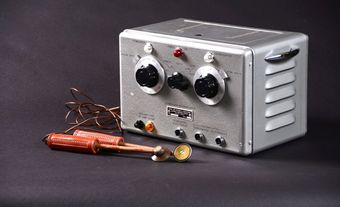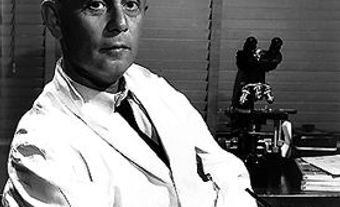John Alexander (Jack) Hopps, OC, inventor, research scientist (born 21 May 1919 in Winnipeg, MB; died 24 November 1998 in Ottawa, ON). Early in his lengthy career at the National Research Council of Canada (NRC), Hopps was recruited to design a cardiac pacemaker with a team of scientists at the Banting Institute in Toronto. His invention of a portable artificial external pacemaker, designed at the NRC, was successfully tested on a dog in 1950. The creation of the device was a significant medical milestone that laid the groundwork for implantable pacemakers in humans.

Early Career
John Alexander (Jack) Hopps was born in Winnipeg, Manitoba, in 1919. He studied electrical engineering at the University of Manitoba, and shortly after graduating in 1941 relocated to Ottawa to work at the National Research Council of Canada (NRC). Established in 1916, the NRC remains Canada’s largest federal research and development organization.
Did you know?
Hopps had experience in scenery and stage design. Shortly after arriving in Ottawa, Hopps was mentioned in the 1942 Ottawa Journal for having “considerable experience with light opera productions” as the scenery designer for a production of H.M.S. Pinafore by the Orpheus Amateur Operatic Society (see also Orpheus Musical Theatre Society of Ottawa).
At the NRC, Hopps worked on developing industrial applications of radio frequency heating. In 1949, while investigating the pasteurization of beer for the O’Keefe Brewery Company Limited (see also Eugene O’Keefe), he was recruited to the cardiovascular laboratory of the Banting Institute in Toronto. Hopps was reluctant to join the team at the Banting Institute. Years later, in a 1981 article for the journal Pacing and Clinical Electrophysiology, he remarked, “I looked upon the Banting task as an annoying interruption to this vital task!”
Cardiac Pacemaker

At the Banting Institute, Dr. Hopps worked with Dr. Wilfred Bigelow, Dr. John C. Callaghan and a team of research scientists who were conducting groundbreaking research at the cardiovascular surgical experimental laboratory, known as Room 64. The team was trying to understand how hypothermia could be used (see Cold-Weather Injuries) for surgery and were looking for a way to stimulate the heart when it faltered as it cooled.
Hopps returned to the NRC’s Ottawa facility, and with the help of technicians created a portable artificial external pacemaker. It was designed to send electric pulses to the heart, which caused the heart to contract and pump blood to the body. The device was successfully tested on a dog in 1950. That same year, Dr. Bigelow and Dr. Callaghan presented the device and their accompanying research at a meeting of the American College of Surgeons in Boston.
Hopps and the team at the Banting Institute made a discovery that paved the way for the use of implantable cardiac pacemakers in humans. This breakthrough also redefined the use of electronic devices in the medical field. The invention of the cardiac pacemaker was discussed in newspapers and journals of the day. The title of an article published in the Saskatoon Star-Phoenix on 31 October 1951 read “Heart machine New Canadian invention.”
Patent

Despite attempts by Dr. Hopps to receive a patent from the NRC, his application was turned down. Around the same time, the Toronto team suspected that many aspects of Dr. Hopps’ design were reused by American cardiologist Dr. Paul Zoll, who was credited for the design of an external pacemaker in 1952. Dr. Hopps continued to work on the pacemaker design and in 1951, along with Dr. Bigelow, he released the Model 3 Stimulator-Defibrillator pacemaker, which was used in a clinical setting on humans in 1951.
Global Impact
Dr. Hopps worked at the NRC for the remainder of his career. When he retired in 1979, he was head of the Medical Engineering Section. He also became involved in several Canadian and international organizations and initiatives. Hopps was a consultant for the Colombo Plan, an international initiative established in the 1950s to tackle poverty in South and Southeast Asia. In 1965, Hopps established the Canadian Medical and Biological Engineering Society (CMBES), based in Ottawa. In 1971, the engineer served as president of the International Federation for Medical and Biological Engineering (IFMBE). From 1985 to 1988, Dr. Hopps was secretary general of the International Union for Physical and Engineering Sciences in Medicine (IUPESM), a non-profit organization based in England that contributes “to the advancement of physical and engineering sciences in medicine for the benefit and well being of humanity.”
Legacy

After working for more than thirty-five years at the NRC, Hopps retired in 1979. For the remainder of his life, he spent time between his residence in Ottawa and a home in Lakeland, Florida. In 1984, the device that Hopps invented was used to prolong
his own life. An implantable pacemaker was installed in the scientist’s chest due to his irregularly beating heart.
In 1998, Hopps passed away from a blood clot. A quote from his obituary in the National Post references a statement Hopps made years ago about his invention: “It’s really a gratifying thing that [the pacemaker] has helped so many people. So many people can live a healthy, full life now, whereas they wouldn’t have been able to.” In 2003, a memorial plaque in honour of Hopps was unveiled on the grounds of the National Research Council of Canada. The plaque reads: “Distinguished scientist recognized globally for the invention of the world's first heart pacemaker and as the Father of Biomedical Engineering in Canada."
Awards and Honours
- Honorary Life Member, International Federation for Medical and Biological Engineering (1976)
- Honorary Doctorate, University of Manitoba (1976)
- Distinguished Scientist Award, North American Society of Pacing and Electrophysiology (1985)
- Recipient, A.G.L. McNaughton Gold Medal, IEEE Canada (1985)
- Officer, Order of Canada (1986)
- Award of Merit, International Union of Physical and Engineering Sciences in Medicine (1991)
- Inductee, Canadian Science and Engineering Hall of Fame (2006)

 Share on Facebook
Share on Facebook Share on X
Share on X Share by Email
Share by Email Share on Google Classroom
Share on Google Classroom





